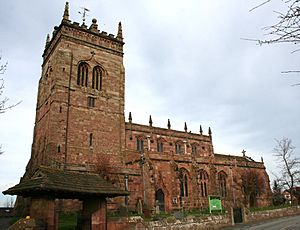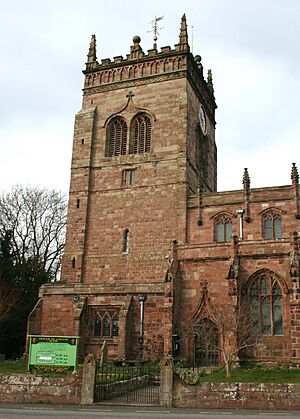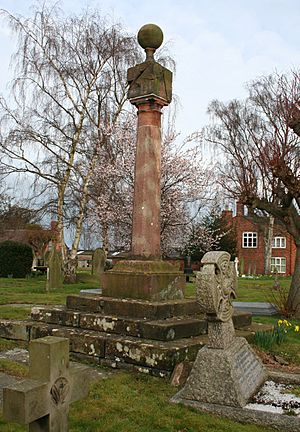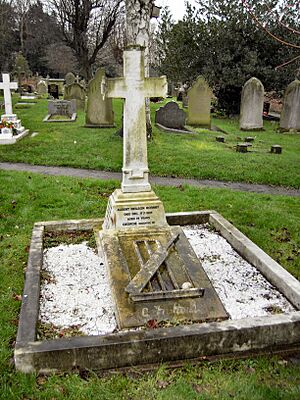St Mary's Church, Acton facts for kids
Quick facts for kids St Mary's Church, Acton |
|
|---|---|

St Mary's Church, Acton, from the southwest
|
|
| Lua error in Module:Location_map at line 420: attempt to index field 'wikibase' (a nil value). | |
| OS grid reference | SJ 631,531 |
| Location | Monk's Lane Acton, Cheshire |
| Country | England |
| Denomination | Anglican |
| Website | St Mary, Acton |
| History | |
| Status | Parish church |
| Dedication | St Mary |
| Architecture | |
| Functional status | Active |
| Heritage designation | Grade I |
| Designated | 12 January 1967 |
| Architect(s) | Austin and Paley (restoration) |
| Architectural type | Church |
| Style | Gothic, Gothic Revival |
| Completed | 1898 |
| Specifications | |
| Materials | Red sandstone, lead roof |
| Administration | |
| Deanery | Nantwich |
| Archdeaconry | Macclesfield |
| Diocese | Chester |
| Province | York |
St Mary's Church is an old and important church located in Acton, a village near Nantwich in Cheshire, England. It is an active Anglican church, meaning it belongs to the Church of England. Since 1967, it has been recognized as a Grade I listed building, which means it is a very important historical building.
A church has stood on this spot for a very long time, even before the Domesday Book was written in 1086. The church's tower is the oldest in Cheshire. It had to be rebuilt after it fell down in 1757. Inside, you can still see old stone seats around the edges, which is quite rare. There are also ancient carved stones from the Norman period (around 1066-1154). St Mary's Church is considered one of the 'best' English parish churches by a famous architectural historian. In the churchyard, there is a tall sundial from the 1600s.
Contents
History of St Mary's Church
A church with two priests was mentioned here in the Domesday Book. This shows how long the church has been a part of the community. In the early 1100s, the church and its lands were given to Combermere Abbey. Later, after monasteries were closed down, the right to choose the church's priest went to the Wilbraham family and then to the Lords Tollemache.
Building the Tower and Aisles
The church's tower was built around 1180, making it the oldest church tower in Cheshire. It was originally over 100 feet (30 meters) tall. However, in March 1757, a storm caused the top of the tower to collapse. This damaged the church roof. The tower was rebuilt, but only to a height of 80 feet (24 meters).
The north side of the church was built in the late 1300s. The south side and the main part of the church where the altar is (called the chancel) were built in the early 1400s.
Changes Over Time
During the English Civil War (1642-1651), the church's inside was damaged. It was repaired in the 1600s and 1700s. Then, in 1897-1898, architects named Austin and Paley carried out a big restoration. They put in new floors and roofs, removed old plaster, rebuilt parts of the walls, added heating, and installed a new pulpit, porches, and doors.
Architecture and Design
St Mary's Church is built from red sandstone and has a lead roof.
Outside the Church
The tower is actually inside the main part of the church. It has arches that lead into the central area (the nave) and the side sections (the aisles). These arches, along with the narrow windows and flat supports (called buttresses), are from the 1200s. It's rare to find such old tower features in Cheshire. The top parts of the tower, rebuilt after 1757, show an early Gothic Revival style.
The main part of the church has four sections, with side aisles that have six sections. The chancel has three sections, with a small room (a vestry) on its north side. The pillars that support the arches inside are from the 1200s, but their tops were added during the 1800s restoration. Most of the church's main body is in the Perpendicular style, which was popular in the late Middle Ages.
At the east end of the north aisle is the Mainwaring chapel, which used to be a special chapel for the Virgin Mary. Near the tower, there's another small chapel called the Dorfold chantry. It's unusual that the old stone seats around the sides of the church are still there.
Inside the Church: Fittings and Furniture
In the Mainwaring chapel, there is a special tomb with a stone canopy for Sir William Mainwaring, who died in 1399. His stone statue (called an effigy) shows him lying down in plate armour like a knight. His head rests on a helmet, and he wears a gold chain. The rest of the tomb is made of red sandstone.
At the east end of the south aisle, there's a marble tomb for Sir Richard Wilbraham (1578–1643) and his son Sir Thomas Wilbraham (1601–1660), along with their wives. It includes marble statues of Sir Thomas and his wife, Elizabeth. Also in the south aisle is an old stone basin (a piscina) that was used for washing sacred vessels. In the chancel, there's another piscina and stone seats (a sedilia), but these are damaged.
The screen in the Dorfold chapel is from 1685. The screen separating the chancel from the nave is newer. The communion rail is also from 1685. A brass chandelier hangs from the 1700s.
Stained Glass and Other Features
The stained glass windows at the east end and in the south aisle were made by Charles Eamer Kempe between 1885 and 1888. Behind the altar, there's a decorated screen (a reredos) that shows the Ten Commandments on one side and the Lord's Prayer and the Creed on the other. The carved oak pulpit and the oak eagle lectern (where readings are given) are from the 1800s.
The baptismal font has a Norman bowl, which is very old. It has carvings of figures and simple designs. For many years, it was in the garden of a nearby house before being brought back into the church.
At the east end of the south aisle, there are carved stones, some made of sandstone and others of limestone. The limestone stones seem to be from the late 1000s, and the sandstone ones from around 1100. These are considered some of the most important Romanesque sculptures in England.
The church has a ring of six bells. Five of them were made in the 1700s, and the sixth in 1893. The church's records of births, marriages, and deaths (parish registers) start in 1653. The organ, which has two keyboards, was built in 1897 and has been updated twice since then.
Outside the Church: Churchyard Features
In the churchyard, there is a tall sandstone sundial that is over 12 feet (3.7 meters) high. It was originally a medieval Christian cross that was turned into a sundial in the late 1600s. It has an eight-sided pole on three stone steps. On top, there's a square cap with a ball on it. Each side of the top has a sundial face. This sundial is a protected historical site.
The red sandstone wall around the churchyard is also a listed building. It was likely rebuilt in 1897 but is based on an older wall. The churchyard also contains the graves of five soldiers from World War I and World War II.
A famous sportsman named A. N. Hornby (1847–1925) is buried here. He was special because he was one of only two people to be captain for England in both cricket and rugby. He also played football for Blackburn Rovers.
Current Activities
St Mary's is still a very active church today. It is part of a group of churches called the Cross Country Group of Parish Churches. These churches share a vicar (the main priest) and three licensed readers. The current vicar is the Rev Anne Lawson.
St Mary's holds two or three church services every Sunday and a special service called Holy Communion every Wednesday. The group of churches also runs community activities. These include "Praise & Play" for young children and their parents, a youth club called "Holy Disorder," and local Guides and Brownies groups. The church is open for visitors and private prayers on Wednesday mornings.
See also
- Grade I listed churches in Cheshire
- List of scheduled monuments in Cheshire (1066–1539)
- Listed buildings in Acton, Cheshire
- List of Norman architecture in Cheshire
- List of ecclesiastical works by Austin and Paley (1895–1916)




